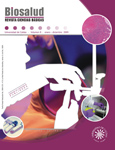Authors
Abstract
After analyzing their antioxidant potential, the essential oils and extracts of Eugenia caryophyllata, Origanum vulgare and Thymus vulgaris with the greatest inhibition to oxidation were selected in order to be analyzed at different concentrations and compared with a reference antioxidant (sodium nitrite) on lipid oxidation and their effect on the organoleptics characteristics in cooked meat products like salami. The antioxidant activity of different essential oils was evaluated by means of several methods (peroxidation inhibition degree of linoleic acid, reduction power assessment, ß-carotene test), in order to demonstrate that treatments with oregano, thyme and clove essential oils significantly reduce oxidation in cooked meat products like salami. These oils were evaluated according to the results of antioxidant and antibacterial activity and the minimum inhibitory concentration (MIC). Positive results were also obtained for clove, which was selected to be added to the formulation of salami, as an antioxidant and preservative. The concentration of the application in salami was carried out with the clove extract. The salami was elaborated based on the procedures established in the practices and formulations manual of the Food Technology Unit of the Universidad de Caldas. The product underwent a series of sensory analysis to determine the effect of the extract added as an antioxidant on the organoleptic properties of salami, which showed positive results. The product showed no significant differences with regards to the pattern, accepted by the judges in the sensory assessment.
Keywords:
References
Mirvish, Sidney. Role of N-nitroso compounds and the nitrosation in etiology of gastric, esophageal, nasopharyngeal and bladder cancer and condition to cancer of known exposures to No nitrosocompounds. Cancer Letters 1995;93:17-47.
Madhavi, Deshpande, SinghaL R.S, Kulkarni P.R. Technological aspects of food antioxidants. In: Madhavi, D.L., Deshpande, S. S. and Salunkhe, D.K., eds. Food Antioxidants.Technological, toxicological and health perspectives. Vol. 4.. Marcel Dekker, Inc: New York; 1996; pp: 159-265.
Ramarathnam, Narasimhan, et al. Studies on Meat Flavor. 1. Qualitative and Quantitative Differences in Uncured and Cured Pork. Journal of Agricultural and Food Chemistry 1991;39:344-350.
Shon, M. Y., Kim T.H. & Sung N.J. Antioxidants and free radical scavenging activity of phellinus baumii extracts. Food Chemistry 2003;82:593-597.
Wettasinghe H. & M Shahidi, F. Antioxidant and free radical scavenging propierties of ethanolic extracts of defatted borage seeds. Food Chemistry 1999;67:399-414.
Bandoniene, D.; Murkovic, M.; Pfannhauser, W.; Venskutonis, P.R.; Gruzdiene, D. Detection and activity evaluation of radical scavenging compounds by using DPPH free radical and online HPLC-DPPH methods. Food Research Technology 2002;214;143-147.
Takaesova, M. et al. Study of the antioxidant effect of thyme, sage, juniper and oregano. Nahrung 1995;3:245-243.
Pietta Pier-giorgo. Electrospray characterization of selected medicinal plant extracts. In: Journal of farmaceutical and biomedical analysis 2000;23(Issue 1):61-68.
Berdhal, Donald, et al. Labiatae herb extracts and hops extracts for extending the color life and inhibiting the growth of microorganisms in fresh meat, fish and poultry. UNITED STATETS. P.A. No. 20040028758. July 2004. [Internet]. Disponible en: http://wwwappft.uspto.gov/netacgi/nphParser?Sect1=PTO§2=HITOF&d=PG01&p=1&u=%2Fnetahtml%2FPTO%2Fsrchnum.hml&r=1&f=g&1=50&s1=%2220040131709%22.PGNR&OS=DN720040131709&RS=DN/20040131709. Consultado Diciembre de 2008.
Ardila Martha I. Evaluación del poder inhibitorio del tomillo, orégano y clavo de olor en el salami [Tesis Ingeniera de Alimentos]. Manizales: Facultad de Ingeniería, Universidad de Caldas; 2008. 124p.
Xiao-Juan Duan, et al. Evaluation of antioxidant property of extract and fractions obtained from a red alga, Plysiphonia urceolata. Food Chemistry 2006;95(Issue 1):37-43.
Kumar, R. S. Antioxidant and antimicrobial activites of Bauhinia racemosa L., stem bark.Brazilian Journal of Medical and Biological Research 2005;38(7):1015-1024.
Dufour Claire, Loonis Michèle and Dangles Olivier. Inhibition of the peroxidation of linoleic acid by the flavonoid quercetin within their complex with human serum albumin. Free Radical Biology and Medicine 2007;43(Issue 2):241-252.
Mistuda. H., Yuasumoto, K. & Iwami, K. Antioxidation action of indole compounds during the autoxidation of linoleic acid. Nihon Eiyo Shokuryo Gakkai-Shi 1996;19:210-214.
Dorman, H.J.D., et al. Antioxidant propierties and composition of aqueus extracts from Mentha species, hybrids, varieties and cultivars. Journal of Agriculture and Food Chemistry 2003;51:4563-4569.
Jayaprakasha, G.K., Singh, R.P. & Sakariah, K.K. Antioxidant activity of grape seed (Vitis vinifera) extracts on peroxidation models in vitro. Food Chemistry 2001;73:285-290.
Tarladgis, Basil G., et al. A destillation method for the quantitative determination of malonaldehyde in rancid foods. Journal of the American Oil Chemists Society 1960;37(1):44-48.
Shahidi, Feridoon, et al. Interactions of sulfanilamide and 2-thiobarbituric acid with malonaldehyde: structure of aadducts and implications in determination of oxidative estate of nitrecured meats. Journal of Agricultural and Food Chemistry 1992;40:1826-1832.
Byrne D.V. Sensory panel consistency during developments a vocabulary for warmed-over flavour. Food Quality and preference 2001;12(3):171-178.
Byrne D.V. Evaluation of pork colour: sensory colour assessment using trained an untrained sensory panellists. Meat Science 2003;63:119-129.
Anzaldúa Antonio. La evaluación sensorial de los alimentos en teoría y practica. España: Editorial Acribia; 1994. p. 63.
Vargas, A. F. Evaluación de aceites esenciales de ajo, cilantro y romero como antioxidantes y conservantes en el salami [Tesis Ingeniero de Alimentos]. Manizales: Facultad de Ingeniería, Universidad de Caldas; 2008. 124p.
M.K. Fasseas, K.C. Mountzouris, P.A. Tarantilis, M. Polissiou, G. Zervas. -tocopheryl acetato supplementation. Food research international 2003;36:207-213.
Botsoglou, N. A. Fletouris, D. J., Florou-Paneri, P., Christaki, E. & Spais, A. B. Inhibition of lipid oxidation in long-term frozen stored chicken meat by ddietary orégano essntial oil and α-tocopheryl acetato supplementation. Food research international 2003;36:207-213.
Botsoglou, N. A. Grigoloulou S. H., Botsoglou, E., Govaris, A. & Papageorgiou, G. The effects of dietary orégano essential oil and α-tocopheryl acetate on lipid oxidation in raw and cooked turkey during refrigerated storage. Meat Science 2003;65:1193-1200.
Instituto Colombiano de Normas Técnicas. NTC 1325. (Quinta actualización). Industrias Alimentarias. Productos cárnicos procesados no enlatados. Biblioteca Universidad de Caldas.
Instituto Colombiano de Normas Técnicas. Colombia. Industrias Alimentarias. Productos cárnicos procesados no enlatados. Norma Técnica Colombiana NTC 1325.
Isabel M. S. and Fernandes-Ferreira Manuel. Essential oils and hydrocarbons from leaves and calli of Origanum vulgare ssp. Virens. Phytochemistry 1998;48(Issue 5):795-799.
Shahidi F, Janitha Pk, Wanasundara PD. Phenolic Antioxidants. Critical, Reviews in Food Science and Nutrition 1992;32:67-103.

 PDF (Español)
PDF (Español)
 FLIP
FLIP














